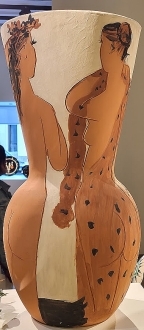Adam Yamey's Blog: YAMEY, page 14
May 23, 2025
Is there a Picasso on your plate?
IT IS ALWAYS WORTH ‘popping’ into Christie’s auction house in London’s Mayfair because there is usually a display of interesting objects being displayed prior to being auctioned. When we visited the place on 16 May 2025, there was a collection of ceramics created by Pablo Picasso (1881-1973). They included plates, jugs, and decorative objects.
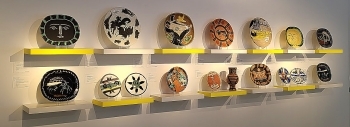
Picasso began producing ceramic objects in 1947. The Madoura pottery studio in Vallauris, France produced blank ceramic items, which Picasso then decorated. A website dedicated to Picasso’s ceramics (https://picasso-ceramics.org/) gives much information about the artist’s involvement in this form of art, and I have quoted from it below. The website explained that Picasso began producing ceramics because:
“… the high prices and relative rarity of Picasso’s paintings meant that most people would never be able to own one, the artist liked the idea of working in a medium that would be more accessible to the average person. He realized that pottery could be produced on a scale that his paintings could not. With prices of around $100 in the 1950s and 1960s, Picasso’s ceramic series were far more financially accessible than his previous artworks. The utilitarian nature of his pottery also made the art form more appealing to the general public, who may not understand the appeal of an abstract painting, but who could appreciate the value of a beautiful plate or pitcher.”
As he had never worked with ceramics before this, he had to develop his techniques and learn how materials behaved when they were incorporated with ceramics. However, his experience with lithography assisted him, as the following explained:
“Since Picasso had no prior training in ceramics, professional potters at Madoura would create blank ceramic objects for him to work with. He would then reshape, paint, and engrave the pottery to create his original designs. Picasso had previous experience engraving lithographs, which informed the methods he used to engrave his pottery, as well as his choice to release the pottery in numbered editions. While this numbering practice was common for lithographs at the time, it was relatively unheard of for pottery.”
The designs on Picasso’s attractive ceramics were largely inspired by Spanish folk art. The auction house beautifully displayed the objects that will come up for sale on 22 May 2025. If you are interested in owning a piece, it is an online auction: https://onlineonly.christies.com/s/picasso-ceramics/lots/3722
May 22, 2025
Yet another visit to a church in Hampstead (north London)
THE PARISH CHURCH OF St John stands at the western end of Hampstead’s elegant Church Row. We have visited it often, and each time we notice things we had not observed on previous visits. During our most recent one (in May 2025), we spotted two things that we had not been aware of previously. One is a small detail, and the other is glaringly obvious now that we have thought about it.

The small detail relates to the font that stands close to the main entrance to the church. It incorporates the bowl of the font that was originally constructed in 1745. The stem that supported it is elsewhere in the church. The font is covered by a wooden lid inlaid with religious images. On top of this cover there is a statue of st John the Baptist standing within a cast-iron frame. What we had not noticed before is that there is a lifting mechanism for raising the lid. This consists of a chain, which is attached to the top of the frame, and then runs over some pulleys, At the other end of the chain there is a heavy looking weight, presumably added to make it easier to raise the heavy cover.
The glaringly obvious thing about this church, which it has taken us years to notice, is that the chancel (containing the high altar) is at the west end of the church. This is unusual because in most churches, the chancel is at the east end. When we were in Pondicherry (in Southern India) in January 2025, we visited two of its churches. Both of them have, as does St John, their chancels at their west ends.
I was brought up near Hampstead, and from my childhood onwards, I have visited this charming hilltop place innumerable times, each time discovering something I had not noticed before. In January 2022, I published a book about Hampstead (which is available from Amazon sites such as https://www.amazon.co.uk/BENEATH-WIDE-SKY-HAMPSTEAD-ENVIRONS/dp/B09R2WRK92).
May 20, 2025
A versatile artist who was born in London
THE CAMDEN ART Centre in London’s Hampstead area rarely puts on exhibitions that can be classed as dull. The current show, which runs until 22 June 2025, is certainly anything but dull. It is a solo exhibition of works by Richard Wright, who was born in London in 1960. After his family moved to Scotland, he attended Edinburgh College of Art from 1978 to 1982 and then was at Glasgow School of Art between 1993 and 1995. He lives in Glasgow and Norfolk. In 2009, he won the prestigious Turner Prize.
From what can be seen in the variety of art works on display in the Art Centre, it is difficult to pigeonhole his art in any particular category. The works that can be viewed in the exhibition include huge wall-paintings, stained glass windows, light-diffusing structures, framed paintings, decorated sculpture, books that have had had paintings added to them, and more. A note in the exhibition handout outlines some of the influences on Wright’s art:
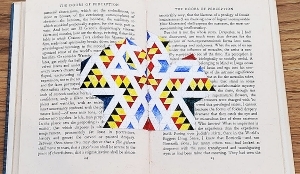
“The exhibition also brings together more than 40 works on paper made over the last 30 years, drawing on languages of signwriting, 1970s subculture, album covers and poster-art, as well as Baroque painting, Renaissance frescoes, Islamic mosaics and early modern artists and movements including Kandinsky, Klee, De Stijl, Mondrian, and Russian Constructivism. Some of these works are made directly into the pages of books, another kind of site, surface or architecture for him to intervene in and occupy.”
Seeing this collection of refreshingly original artworks in the brightly lit galleries of the Camden Art Centre was a delightful experience.
Pablo Picasso and pottery
May 19, 2025
Using his fingers to create works of art
AMOAKO BOAFO WAS born in Accra (Ghana) in 1984, where he works and lives. After teaching himself to draw and paint in his childhood, he was engaged in various professions before he studied art at Ghanatta College of Art and Design in Accra. There, he was awarded a prize for being the best portrait painter in his year. In 2013. Boafo moved to Vienna (Austria) where he was the co-founder of a centre for artists of colour and LGBTQ+ voices.
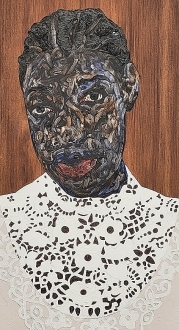
Because of the marginalisation of Black people he noticed in Austria, Boafo began to specialise in portraying Black people. As the gallery’s website noted, he is:
“Inspired by the expressionistic portraiture of Vienna Secession artists Gustav Klimt and Egon Schiele, he counts among his contemporary influences Jordan Casteel, Maria Lassnig, Kerry James Marshall, and Kehinde Wiley.”
Looking at the faces in Boafo’s paintings on display at the Gagosian Gallery in London’s Mayfair until 24 May 2025, I could see the influences of Klimt and Schiele in them. Many of the paintings include depictions of patterned fabrics and wallpaper. What makes his paintings fascinating is that instead of using brushes, Boafo paints the faces and bodies of his subjects with his fingertips. The effect produced is curiously mosaic-like.
Part of the exhibition in Gagosian is hung conventionally in a large room. In another part, in a separate room, Boafa’s paintings have been hung in a life-size reconstruction of the courtyard of his childhood home in Ghana. In addition to the paintings, there is a display of playing cards designed by the artist. In brief, I am pleased that we visited this exhibition of works by a refreshingly original artist.
May 18, 2025
Gone forever: a wonderful bookshop in Bangalore (Bengaluru)
HERE IS A BRIEF excerpt from my book “CORACLES AND CROCODILES: 101 TALES OF INDIA”. It comes from a chapter on the booksellers in Bangalore (Bengaluru), and is about a remarkable bookshop that, sadly, no longer exists. Here is the extract from my book:
“Premier, one of the most fantastic bookshops that has ever existed, is also no more. It closed some years ago when its owner, Mr Shanbag, retired. I felt almost as if I had suffered a bereavement when I arrived where the shop used to be located on the short stretch of Museum Road between MG Road and Church Street, and found that it was no longer there. I still mourn its passing.
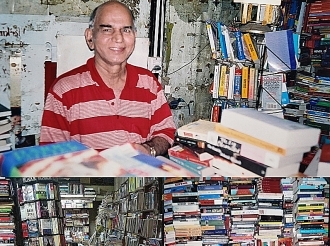
From the outside, Premier could have been mistaken for a newsagent. A rack of magazines stood by the shop’s entrance. When you stepped inside, you felt as if you had entered a book-lover’s Aladdin’s Cave. Mr Shanbag, who was related to the founder of Strand Bookstall in Bombay, used to sit by the entrance, hidden behind the piles of books and bits of paper cluttering up his tiny desk. The rectangular shop’s walls were lined with books stacked one upon each other, from floor to ceiling. A central divider was covered in books. Two narrow corridors ran along the length of the shop allowing customers and staff to penetrate the dingy depths of the establishment. Deep inside the shop there was a narrow, book-lined passageway connecting the two main corridors. This was so narrow that most adults, and obese children, needed to progress sideways along this claustrophobic book lined chasm.
In most bookshops, customers can pick a book from a shelf, browse it, and then replace it if necessary. This was not the case at Premier. Only the foolhardy or a newcomer to the shop would attempt to take a book from the tall, precariously stacked piles on Premier’s bookshelves. A 19th century French composer, Alkan, was killed when he was crushed by books collapsing on him in his library. A possible injury awaited any customer who attempted to withdraw a book from Premier’s hazardously stacked shelves. One could say that the books were stacked perilously. One careless move would initiate an avalanche of literature – both fiction and non-fiction. This often happened. Shanbag would raise an eyebrow, and then he or one of his assistants would restore ‘order’ in the shelves.
You may well wonder how customers ever managed to browse in Premier. It was simple. All that was necessary was to ask Shanbag or one of his helpers to retrieve the book for you. If you were unable to see the book that you desired amongst the huge number of volumes stacked in the shop, Shanbag would be able to tell you instantly whether he had it in stock, without resorting to a computer or any form of catalogue. He knew exactly what he had in his shop, and where a book was located if he stocked it. And when you had made your selection, he would prepare a bill, and then knock 20% off the final total if you paid in cash.
A remarkable thing about Shanbag was his great understanding of his regular customers’ reading habits. He could remember what each customer had bought previously …”
You can find out more about Premier as well as many aspects of life in India in my book/Kindle, which is available from Amazon stores such as: https://www.amazon.co.uk/CORACLES-CROCODILES-101-TALES-INDIA/dp/B0DJZ6DMYB/
May 17, 2025
Do not expect to get your prescription honoured at this pharmacy
LOVE HIM OR HATE him, there is no denying that the artist Damien Hirst (born 1965) has plenty of imagination. Between 1997 and 2003, he created a restaurant in London’s Notting Hill Gate. It was called Pharmacy, but had to change its name after the Royal Pharmaceutical Society of Great Britain objected to it. Its new names were anagrams of the old: first Achy Ramp, and then Army Chap. Its decorative theme was pharmaceutical. For example, its walls were lined with cupboards containing (empty) drug and medicine packaging, as well as clinical equipment. It gave the visitor the impression of being in part of a busy hospital or clinic. From what I can remember of the place, its décor was vastly more exciting than the costly fare served to its customers. I was sad when it closed as it was a distinctive landmark in the area.
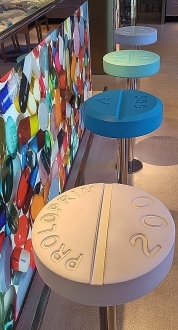
In 2016, Damien Hirst opened Pharmacy 2 on the first floor of his recently completed Newport Street Gallery (near Lambeth Palace). For a few years, this pharmacy themed restaurant offered a range of food and drinks, none of which were cheap. The interior of Pharmacy 2 follows on from the original art-installation-cum-restaurant design of the Notting Hill Gate version. An online article (www.dezeen.com/2016/02/18/damien-hirst-pharmacy-2-restaurant-mark-hix-newport-street-gallery-caruso-st-john-london/) describes the place well:
“Similar to its predecessor, which was designed by Barber & Osgerby’s interiors company Universal Design Studio, the interior follows a clinical theme inspired by Hirst’s 1992 artwork Pharmacy. Images of tablets and brightly coloured pills have been embroidered onto leather banquettes and embedded into the marble floor. Bar stools are topped with pastel-coloured pill-shaped seats. Walls are covered with a silver-coloured wall chart of pills and pharmaceutical products first produced for the original Pharmacy restaurant … A neon prescriptions sign hangs above the bar, along with a series of sculptures based on molecular structures. Windows are covered with dark-coloured translucent vinyls. Stark lighting is used to reaffirm the restaurant’s pharmaceutical theme.”
These words give some idea about this fantastic place, but it must be seen to be believed.
Pharmacy 2 has not been functioning as a restaurant for several years. When we visited Newport Street Gallery in May 2025, Pharmacy 2 was open to the public, and visitors can serve themselves with tea and coffee without charge. On each of the restaurant’s tables, there are art books for visitors to browse. The young man, an invigilator, who was keeping an eye on the place told us that occasionally the restaurant is revitalised for feeding visitors participating in special events. At these ‘pop-up’ events, meals are costly.
Pharmacy 2, like its predecessor in Notting Hill Gate, is an art installation. It is appropriate that the canteen of the Newport Street Gallery is not merely a restaurant but also an amazing work of art.
The imagination of an artist and artificial intelligence (AI)
DAVID SALLE WAS born in 1952 in Oklahoma (USA). Between 1970 and 1975, he studied at the California Institute of the Arts. A painter, he lives and works in Brooklyn, New York. There is an exhibition of his strange, colourful paintings at the Thaddeus Ropac Gallery in London’s Dover Street until 8 June 2025.
The paintings on display are strange compositions in which everything seems to be in the wrong place, perspective is confused, and the laws of gravity seem to have been forgotten. Yet the objects and people in the paintings have been depicted in a straightforward way, without distortion or abstraction. What was going on in the artist’s mind?
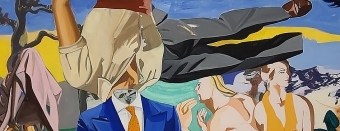
Salle, an innovative artist interested in developing new techniques, has employed artificial intelligence (‘AI’) to help him compose these images. Let me explain. Between 1999 and 2001, Salle produced a series of paintings inspired by a nineteenth century opera backdrop. He scanned these images into a machine with AI capabilities, and then, without providing any text prompts or instructions, he got the machine to use its AI to warp the scenes on his paintings to create new images that contain and reconfigure all the elements in his original pictures. In this way, he obtained new compositions, on which he has based his new paintings – those on display at Thaddeus Ropac. Regarding Salle’s innovation, the gallery’s press release noted:
“Painting is a technology in its own right, one that, as the history of art attests, has advanced over millennia through relentless modification and reinvention. For Salle, it is incumbent on the artist to make use of the tools available in their time, whether egg tempera, oil paint or photography. AI is useful ‘since it doesn’t know what it’s doing,’ he says. ‘It can violate all the rules of depiction without a pang of conscience.’ Like the human eye, it rapidly scans, processes and distils an endless stream of visual information … Avoiding the pitfalls of ‘generic’ digital imagery, the result is a highly concentrated visual vocabulary, which is enriched and intensified by further layers of overpainting. In concert with the reverberations of his past pictorial invention, Salle stages what curator Nancy Spector describes as a ‘duet for one’.”
This exhibition show how AI can be used intelligently and imaginatively by those working in the arts. Even if one had no inkling that Salle had created the paintings with the help of AI, what can be seen of his work at Thaddeus Ropac is both attractive and intriguing.
May 16, 2025
The Power and the Glory by Connor Hirst in south London
THE NEWPORT STREET Gallery, which is in a side street not far from Lambeth Palace and the Garden Museum, was opened in October 2015. Housed in a building originally built in 1913 as a theatre carpentry and scenery production workshop, these spacious premises are used to display selections from the huge number of works that have been collected over the years by the artist Damien Hirst. The current exhibition, which has been curated by Damien’s son Connor Hirst, is called “The Power and the Glory”, and is showing until 31 August 2025.
The walls of the rooms in the gallery are lined with photographs of atomic and hydrogen bomb test explosions (‘mushroom clouds’ etc.), as well as of the devastation that the former caused in Hiroshima and Nagasaki. Although many of the photographs are beautiful as works of art, they are grim reminders of the horrific destructive forces unleashed by detonating nuclear bombs. However, as the curator explained, many of the photographs have been composed in such a way that the viewer is unaware of the destruction going on beneath the picturesque clouds.

While the walls of the rooms are lined with photographs, the rooms contain many beautifully shaped (mostly shaped by nature) pieces of rock. They include a selection of so-called ‘scholar’s rocks’. These have been collected in China since the Song Dynasty (960-1279 AD), and appreciated for their inherent beauty. Most of them were found either in caves in Guandong province or at Lake Tai or in the Lingbi region. Amongst the collection of scholar rocks, there are some Japanese ‘water stones’, which are often shaped like mountains and waterfalls.
The stones are intrinsically beautiful and provide an interesting contrast to the photographs surrounding them. However, although the rocks and photographs served different functions, when displayed together as they are at the Newport Street Gallery, they cannot help becoming interlinked in the viewers’ minds. I could not help thinking that these rocks could easily have been similar to the fragments of buildings destroyed by the bombs at Hiroshima and Nagasaki.
May 15, 2025
Out to lunch in the countryside of Hertfordshire
EVERY NOW AND THEN, we feel the need to leave London, and sample the country life. Recently, we decided to visit Buntingford, a small town in Hertfordshire and to eat lunch at a pub nearby. Using the Internet, we chose one at random. It was the Sword Inn Hand in the hamlet of Westmill, which is a few miles south of Buntingford.
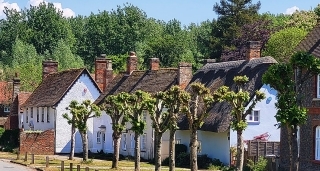
It was an excellent choice for two reasons. First, Westmill is a neat, picturesque little settlement. Secondly, the pub served excellent food in a pleasant ambience and, more importantly, the staff were friendly and extremely obliging. The pub has been in existence since the 14th century but looks as if it has been modified considerably since then. It is next door to the grounds of the medieval parish church, which was locked when we were in Westmill.
After visiting some family members in nearby Baldock, we returned to London, having had a satisfactory few hours’ experience of country life.

